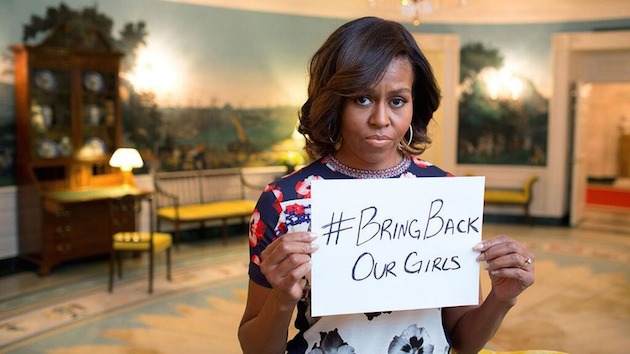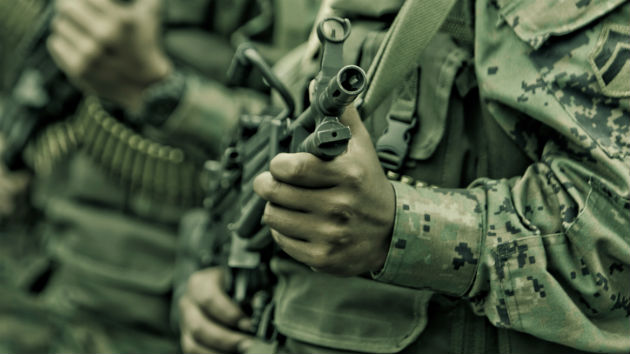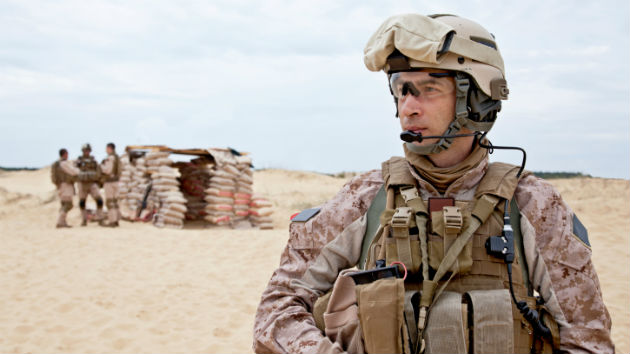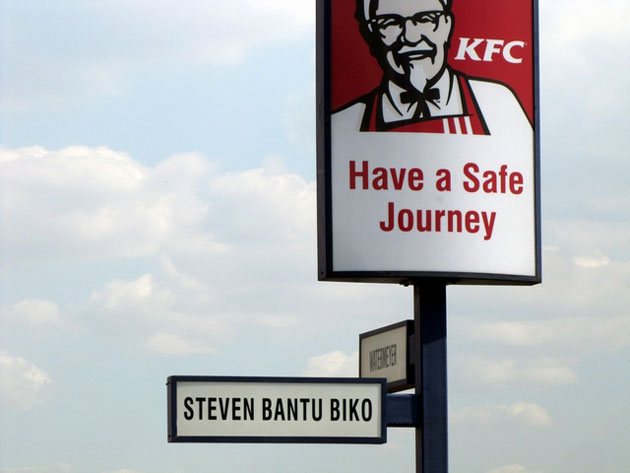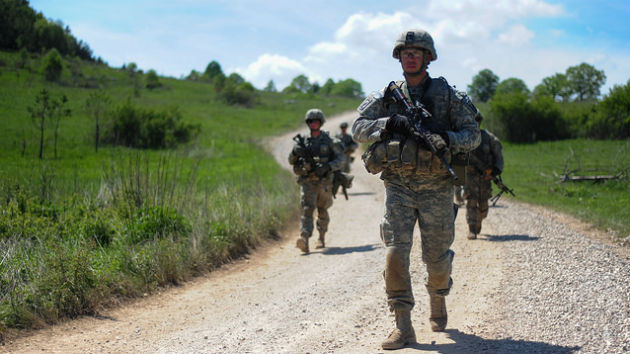
<a href="https://www.flickr.com/photos/soldiersmediacenter/with/14158087463/">US Army</a>/Flickr
This story first appeared on the TomDispatch website.
What is Operation New Normal?
It’s a question without an answer, a riddle the US military refuses to solve. It’s a secret operation in Africa that no one knows anything about. Except that someone does. His name is Lieutenant Colonel Robert E. Lee Magee. He lives and breathes Operation New Normal. But he doesn’t want to breath paint fumes or talk to me, so you can’t know anything about it.
Confused? Stay with me.
![]() Whatever Operation New Normal may be pales in comparison to the real “new normal” for US Africa Command (AFRICOM). The lower-cased variant is bold and muscular. It’s an expeditionary force on a war footing. To the men involved, it’s a story of growth and expansion, new battlefields, “combat,” and “war.” It’s the culmination of years of construction, ingratiation, and interventions, the fruits of wide-eyed expansion and dismal policy failures, the backing of proxies to fight America’s battles, while increasing US personnel and firepower in and around the continent. It is, to quote an officer with AFRICOM, the blossoming of a “war-fighting combatant command.” And unlike Operation New Normal, it’s finally heading for a media outlet near you.
Whatever Operation New Normal may be pales in comparison to the real “new normal” for US Africa Command (AFRICOM). The lower-cased variant is bold and muscular. It’s an expeditionary force on a war footing. To the men involved, it’s a story of growth and expansion, new battlefields, “combat,” and “war.” It’s the culmination of years of construction, ingratiation, and interventions, the fruits of wide-eyed expansion and dismal policy failures, the backing of proxies to fight America’s battles, while increasing US personnel and firepower in and around the continent. It is, to quote an officer with AFRICOM, the blossoming of a “war-fighting combatant command.” And unlike Operation New Normal, it’s finally heading for a media outlet near you.
Ever Less New, Ever More Normal
Since 9/11, the US military has been ramping up missions on the African continent, funneling money into projects to woo allies, supporting and training proxy forces, conducting humanitarian outreach, carrying out air strikes and commando raids, creating a sophisticated logistics network throughout the region, and building a string of camps, “cooperative security locations,” and bases-by-other-names.
Click here to see a larger version
From a 2013 US Army Africa briefing slide referencing Operation New Normal.
All the while, AFRICOM downplayed the expansion and much of the media, with a few notable exceptions, played along. With the end of the Iraq War and the drawdown of combat forces in Afghanistan, Washington has, however, visibly “pivoted” to Africa and, in recent weeks, many news organizations, especially those devoted to the military, have begun waking up to the new normal there.
While daily US troop strength continent-wide hovers in the relatively modest range of 5,000 to 8,000 personnel, an under-the-radar expansion has been constant, with the US military now conducting operations alongside almost every African military in almost every African country and averaging more than a mission a day.
This increased engagement has come at a continuing cost. When the US and other allies intervened in 2011 to aid in the ouster of Libyan dictator Muammar Gaddafi, for instance, it helped set off a chain reaction that led to a security vacuum destabilizing that country as well as neighboring Mali. The latter saw its elected government overthrown by a US-trained officer. The former never recovered and has tottered toward failed-state status ever since. Local militias have been carving out fiefdoms, while killing untold numbers of Libyans—as well, of course, as US Ambassador J. Christopher Stevens and three other Americans in a September 2012 attack on the US consulate in Benghazi, the “cradle” of the Libyan revolution, whose forces the US had aided with training, materiel, and military might.
 Quickly politicized by Congressional Republicans and conservative news outlets, “Benghazi” has become a shorthand for many things, including Obama administration cover-ups and misconduct, as well as White House lies and malfeasance. Missing, however, has been thoughtful analysis of the implications of American power-projection in Africa or the possibility that blowback might result from it.
Quickly politicized by Congressional Republicans and conservative news outlets, “Benghazi” has become a shorthand for many things, including Obama administration cover-ups and misconduct, as well as White House lies and malfeasance. Missing, however, has been thoughtful analysis of the implications of American power-projection in Africa or the possibility that blowback might result from it.
Far from being chastened by the Benghazi deaths or chalking them up to a failure to imagine the consequences of armed interventions in situations whose local politics they barely grasp, the Pentagon and the Obama administration have used Benghazi as a growth opportunity, a means to take military efforts on the continent to the next level. “Benghazi” has provided AFRICOM with a beefed-up mandate and new clout. It birthed the new normal in Africa.
The Spoils of Blowback
Those 2012 killings “changed AFRICOM forever,” Major General Raymond Fox, commander of the II Marine Expeditionary Force, told attendees of a recent Sea-Air-Space conference organized by the Navy League, the Marine Corps, the Coast Guard, and the Merchant Marine. The proof lies in the new “crisis response” forces that have popped up in and around Africa, greatly enhancing the regional reach, capabilities, and firepower of the US military.
Following the debacle in Benghazi, for instance, the US established an Africa-focused force known as Special-Purpose Marine Air-Ground Task Force-Crisis Response (SP-MAGTF CR) to give AFRICOM quick-reaction capabilities on the continent. “Temporarily positioned” at Morón Air Base in Spain, this rotating unit of Marines and sailors is officially billed as “a balanced, expeditionary force with built-in command, ground, aviation, and logistics elements and organized, trained, and equipped to accomplish a specific mission.”
Similarly, Benghazi provided the justification for the birthing of another rapid reaction unit, the Commander’s In-Extremis Force. Long in the planning stages and supported by the head of the Special Operations Command, Admiral William McRaven, the Fort Carson, Colorado-based unit—part of the 10th Special Forces Group—was sent to Europe weeks after Benghazi. Elements of this specialized counterterrorism unit are now “constantly forward deployed,” AFRICOM spokesman Benjamin Benson told TomDispatch, and stand “ready for the commander to use, if there’s a crisis.”
The East Africa Response Force (EARF), operating from the lone avowed American base in Africa—Camp Lemonnier in Djibouti—is another new quick-reaction unit. When asked about EARF, Benson said, “The growing complexity of the security environment demonstrated the need for us to have a [Department of Defense]-positioned response force that could respond to crises in the African region.”
In late December, just days after the 1st Combined Arms Battalion, 18th Infantry Regiment, out of Fort Riley, Kansas, arrived in Djibouti to serve as the newly christened EARF, members of the unit were whisked off to South Sudan. Led by EARF’s commander, Lieutenant Colonel Lee Magee, the 45-man platoon was dispatched to that restive nation (midwifed into being by the US only a few years earlier) as it slid toward civil war with armed factions moving close to the US embassy in the capital, Juba. The obvious fear: another Benghazi.
Joined by elements of the Special-Purpose Marine Air-Ground Task Force-Crisis Response and more shadowy special ops troops, members of EARF helped secure and reinforce the embassy and evacuate Americans. Magee and most of his troops returned to Djibouti in February, although a few were still serving in South Sudan as recently as last month.
South Sudan, a nation the US poured much time and effort into building, is lurching toward the brink of genocide, according to Secretary of State John Kerry. With a ceasefire already in shambles within hours of being signed, the country stands as another stark foreign policy failure on a continent now rife with them. But just as Benghazi proved a useful excuse for dispatching more forward-deployed firepower toward Africa, the embassy scare in South Sudan acted as a convenient template for future crises in which the US military would be even more involved. “We’re basically the firemen for AFRICOM. If something arises and they need troops somewhere, we can be there just like that,” Captain John Young, a company commander with the East Africa Response Force, told Stars and Stripes in the wake of the Juba mission.
The New Normal and the Same Old, Same Old
A batch of official Army Africa documents obtained by TomDispatch convinced me that EARF was intimately connected with Operation New Normal. A July 2013 briefing slide, for instance, references “East Africa Response Force/New Normal,” while another concerning operations on that continent mentions “New Normal Reaction Force East.” At the same time, the phrase “new normal” has been increasingly on the lips of the men running America’s African ops.
Jason Hyland, a 30-year State Department veteran who serves as Foreign Policy Advisor to Brigadier General Wayne Grigsby, the commander of Combined Joint Task Force-Horn of Africa (CJTF-HOA), for instance, told an interviewer that the task force “is at the forefront in this region in implementing US policy on the ‘new normal’ to protect our missions when there are uncertain conditions.”
A news release from CJTF-HOA concerning the Juba operation also used the phrase: “While the East Africa Response Force was providing security for the embassy, additional forces were required to continue the evacuation mission. Under the auspices of ‘the new normal,’ which refers to the heightened threat US Embassies face throughout the world, the SP-MAGTF CR arrived from Morón, Spain,” wrote Technical Sergeant Jasmine Reif.
Earlier this year in Seapower magazine, the commander of Special-Purpose Marine Air-Ground Task Force Crisis Response, Colonel Scott Benedict, described the “new normal” as a world filled with “a lot of rapidly moving crises,” requiring military interventions and likened it to the Marine Corps deployments in the so-called Banana Wars in Central America and the Caribbean in the early twentieth century.
On a visit to Camp Lemonnier, Marine commandant General James Amos echoed the same sentiments, calling his troops “America’s insurance policy.” Referencing the Marine task force, he invoked that phrase in an even more expansive way. Aside from “winning battles” in Afghanistan, he said, the creation of that force was “probably the most significant thing we’ve done in the last year-and-a-half as far as adjusting the Marine Corps for what people are now calling the new normal, which are these crises that are happening around the world.”
In March, Brigadier General Wayne Grigsby explicitly noted that the phrase meant far more than simple embassy security missions. “Sitting in Djibouti is really the new normal,” the CJTF-HOA commander said. (He was, in fact, sitting in an office in that country.) “It’s not the new normal… as far as providing security for our threatened embassies. It’s really the new normal on how we’re going to operate as a [Department of Defense entity] in supporting the national security strategy of our country.”
Operation New Normal and the Incredible Disappearing Lee Magee
With so many officials talking about the “new normal” and with documents citing a specific operation sporting the same name, I called up AFRICOM’s media chief Benjamin Benson looking for more information. “I don’t know the name new normal,” he told me. “It isn’t a term we’re using to define one of the operations.”
That seemed awfully curious. An official military document obtained by TomDispatch explicitly noted that US troops would be deployed as part of Operation New Normal in 2014. The term was even used, in still another document, alongside other code-named operations like Juniper Micron and Observant Compass, missions to aid the French and African interventions in Mali and to degrade or destroy Joseph Kony’s murderous Lord’s Resistance Army in central Africa.
Next, I got in touch with Lieutenant Colonel Glen Roberts at CJTF-HOA and explained that I wanted to know about Operation New Normal. His response was effusive and unequivocal: I should speak with Lee Magee—that is Lieutenant Colonel Robert E. Lee Magee, a West Point graduate, third-generation Army officer, and commander of the East African Response Force who had deployed to South Sudan as the nation shattered on the rocks of reality. “He lives this concept and has executed it,” was how Roberts put it.
Was I available to talk to Magee the next day? Yes, indeed.
On March 27th, the day of the proposed interview, however, a lower-ranking public affairs official got in touch to explain that Lieutenant Colonel Magee could not speak to me and Lieutenant Colonel Roberts was out of the office. I asked to reschedule for the next day. The spokesman said he didn’t know what their calendars looked like, but that Roberts was expected back later that day. I left a message, but heard nothing.
The next morning, I called the press office in Djibouti and asked to speak to Magee. He wasn’t there. No one was. Everyone had left work early. The reason? “Paint fumes.”
That was a new one.
Another follow-up and Roberts finally got back in touch. “Apologies, but I am no longer able to arrange an interview with Magee,” he informed me. “Thanks for understanding.”
But I didn’t understand and told him so. After all, Magee was the man who lived and executed the new normal. I thought we were set for an interview. What happened?
“He has simply declined an interview, as is his privilege,” was the best Roberts could do. Magee had been dropped into the hot zone in South Sudan to forestall the next Benghazi, and had previously spoken with other media outlets about his work in Africa, but conversing with me about Operation New Normal was apparently beyond the pale. Or maybe it had something to do with those paint fumes.
On March 31st, Roberts told me that he could answer the questions by email—questions that I had already sent in on March 17th. But no response came. I followed up again. And again. And again. I sent the questions a second time.
As of publication, almost two months after my initial inquiry, no word yet. That, evidently, is the new normal, too.
The Real New Normal
Quite obviously, the US military isn’t eager to talk about Operation New Normal, which—despite Benjamin Benson’s contentions, Lee Magee’s silence, and Glen Roberts’ disappearance—is almost certainly the name for a US military mission in East Africa that, US documents suggest, is tied to the Benghazi-birthed East African Response Force.
More important than uncovering the nature of Operation New Normal, however, is recognizing the real new normal in Africa for the US military: ever-increasing missions across the continent—now averaging about 1.5 per day—ever more engagement with local proxies in ever more African countries, the construction of ever more new facilities in ever more countries (including plans for a possible new compound in Niger), and a string of bases devoted to surveillance activities spreading across the northern tier of Africa. Add to this impressive build-up the three new rapid reaction forces, specialized teams like a contingent of AFRICOM personnel and officials from the FBI and the departments of Justice, State, and Defense created to help rescue hundreds of Nigerian schoolgirls kidnapped by members of the Islamic militant group Boko Haram, and other shadowy quick-response units like the seldom-mentioned Naval Special Warfare Unit 10.
“Having resources [on the continent] that are ready for a response is really valuable,” Benson told me when talking about the Djibouti-based EARF. The same holds for the US military’s new normal in Africa: more of everything valuable to a military seeking a new mission in the wake of two fading, none-too-successful wars.
The Benghazi killings, unrest in South Sudan, and now the Boko Haram kidnappings have provided the US with ways to bring a long-running “light footprint in Africa” narrative into line with a far heavier reality. Each crisis has provided the US with further justification for publicizing a steady expansion on that continent that’s been underway but under wraps for years. New forces, new battlefields, and a new openness about a new “war,” to quote one of the men waging it. That’s the real new normal for the US military in Africa—and you don’t need to talk to Lieutenant Colonel Lee Magee to know it.
Nick Turse is the managing editor of TomDispatch.com and a fellow at the Nation Institute. A 2014 Izzy Award winner, his pieces have appeared in the New York Times, the Los Angeles Times, and the Nation, at the BBC and regularly at TomDispatch. He is the author most recently of the New York Times bestseller Kill Anything That Moves: The Real American War in Vietnam (now out in paperback).
Follow TomDispatch on Twitter and join us on Facebook and Tumblr. Check out the newest Dispatch Book, Ann Jones’s They Were Soldiers: How the Wounded Return From America’s Wars—The Untold Story. To stay on top of important articles like these, sign up to receive the latest updates from TomDispatch.com here.
